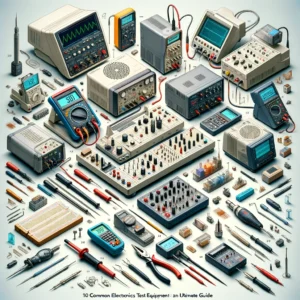Understanding PDN Fundamentals in PCB
The consequences of a poorly designed PDN are significant, ranging from intermittent issues to complete system failures.
We invite you to peruse the information we’ve compiled on this subject. Join us as we explore the crucial aspects of PDN design in PCBs through our guide.
The Significance of PDN in PCB Design
Maintaining power integrity in PCB design is a challenge that grows with each design iteration. As core voltages decrease to 1.2V and below, the current demands inevitably rise, leading to increased IR drop (IR drop = I * R). Moreover, the push towards more compact electronics necessitates fewer layers and denser circuit designs, leaving less room for power nets. Vias introduce further complications, often creating a “Swiss cheese” effect in power planes.
The life of a PCB designer is strewn with PDN challenges—interpreting varied instructions from hardware designers or power integrity engineers that come through different communication channels such as emails and calls, or conventional wisdom. These directives need to be assimilated and applied across numerous power supplies. After which, the designer faces further requests to minimize size, reduce layers and components, often within impractical timeframes.
Electromagnetic Interference (EMI) Considerations
As circuit speeds increase, susceptibility to EMI from both internal and external sources can become a more pressing issue. To mitigate EMI-related problems, strategic configuration of power and ground planes can provide effective shielding.
Addressing Ground Bounce Issues
Concurrently switching digital signals can result in simultaneous switching noise (SSN) or ground bounce. This is a typical occurrence in memory or data buses and can lead to signal levels failing to return to their intended reference ground level, causing them to bounce above it.
Such noise can interfere with proper circuit operation and may induce false switching. A robust PDN minimizes these effects by stabilizing the ground level.
Try PCBPit for the best PCB manufacturing solution >>
Managing Power Ripples
Noise or ripples can also be generated by the power supply’s switching actions, leading to crosstalk in adjacent circuitry and negatively impacting signal integrity in those circuits.
Defining PDN Impedance in PCB
A PDN encompasses every component connected to the voltage and ground rails, including the power and ground planes, interconnecting buses, decoupling capacitors fostering power stability, and any copper features linking to the primary power rails. The PDN impedance comprises parasitic effects such as capacitance and inductance from connections to integrated circuits (ICs).
Key parasitic elements that significantly influence PDN impedance include:
- Plane Capacitance – Capacitance existing between the PDN’s plane layers.
- Capacitor Inductance – Parasitic inductance from capacitor leads, affecting self-resonance.
- Trace Inductance – Inductive contributions from power-delivering traces to the overall PDN.
Why PDN Impedance Matters in PCB Design
The importance of PDN impedance is well known among high-speed and high-frequency designers, and soon enough, all designers will need to adopt this knowledge with advancing technology. Here we consolidate the crucial impact of PDN impedance on PCB behavior:
Power Bus Noise Implications
Transient currents can cause voltage fluctuations or ripples within your PCB, which is directly influenced by the PDN’s impedance profile across different frequencies.
Damping of Power Bus Oscillations
Ringing or underdamped oscillations might become evident on the power bus, potentially resulting from improper sizing of decoupling capacitors or neglecting their self-resonance frequencies.
Necessity of Adequate Decoupling
Traditional capacitors are increasingly unable to provide sufficient decoupling in fast logic PCBs due to their limited self-resonance frequencies (around 100 MHz). To compensate, designers are leveraging interplane capacitance and newer capacitors with self-resonance frequencies in the GHz range to achieve adequate decoupling in high-speed and high-frequency PCB applications.
Share:
More Posts

PCB Ruler: A Comprehensive Guide
PCB Ruler: A Comprehensive Guide What is a PCB Ruler? A PCB ruler is a functional tool made from the same materials as a printed

Thermal Vias: A Comprehensive Guide for PCB Heat Management
Thermal Vias: A Comprehensive Guide for PCB Heat Management Why Heat Management Matters in PCBs Before diving into thermal vias, let’s understand why heat is

PCB Testing Guide: Everything You Need to Know
PCB Testing Guide: Everything You Need to Know This guide will walk you through the essentials of PCB testing, including why it matters, common testing

What Is A Rogers PCB?
What Is A Rogers PCB? If you’ve ever used a smartphone, connected to Wi-Fi, or marveled at satellite communication, you’ve indirectly interacted with a technology

